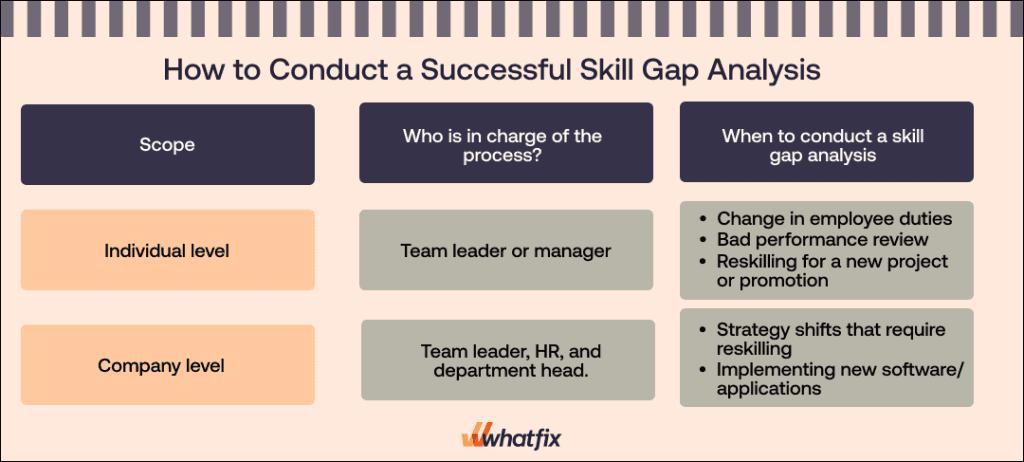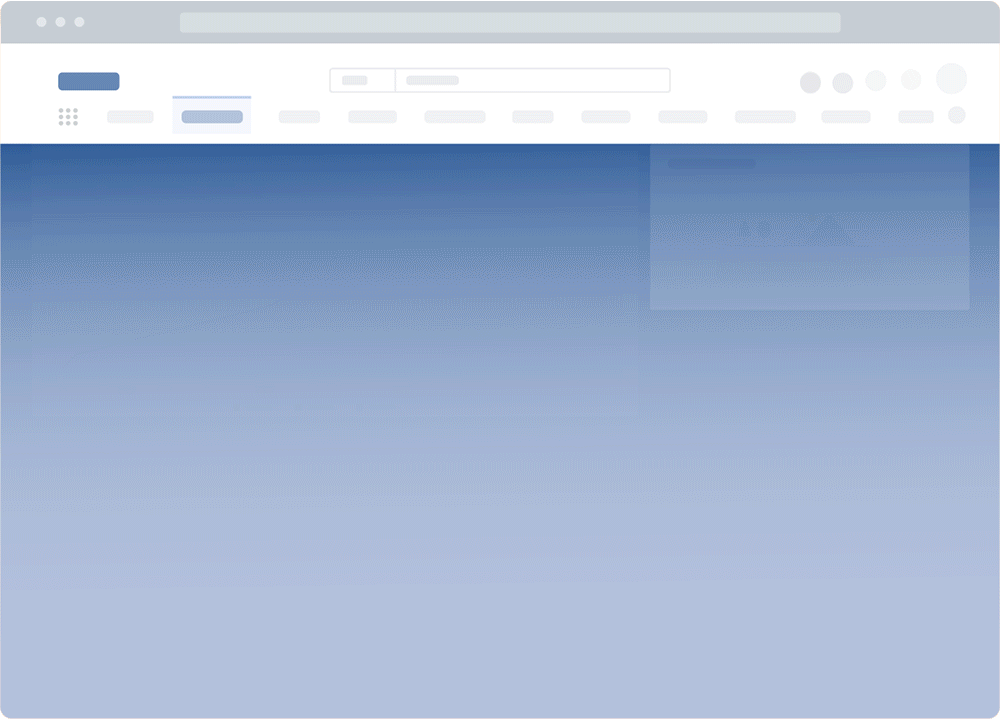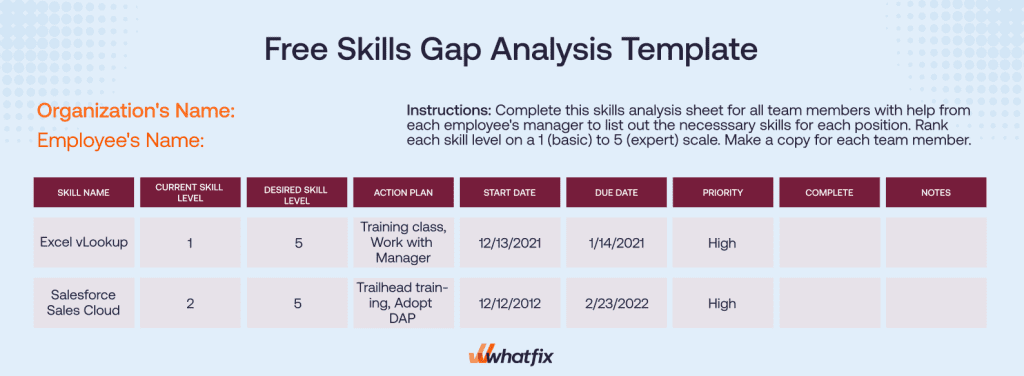According to a Closing Skills Gap report, 69% of HR professionals surveyed said their organization faces a growing skills gap challenge, up from 55% in 2021.
A skills gap is a discrepancy between the skills required to work for a certain job or industry and the skills that job seekers or employees currently have. With the rise of digital transformation and emerging technologies such as cloud computing, AI, automation, and big data redefining work, skill gaps are becoming common.
A skills gap analysis enables HR and L&D teams to assess their employees’ competencies and knowledge, identify gaps, and target these gaps with upskilling.
In this article, we’ll explore the concept of conducting a skills gap analysis and creating an action plan to overcome the skill gap challenges and work towards building an efficient workforce.
What Is a Skill Gap Analysis?
Skill gap analysis is the process of identifying the difference between the skills currently possessed by employees and the skills needed to achieve the organization’s goals. This involves defining the necessary skills and competencies for various roles, assessing the current skills of employees through self-assessments, performance reviews, and standardized tests, and pinpointing areas where development and training are required.
The objective is to ensure that the workforce is adequately equipped to meet both present and future demands, enhancing overall organizational performance and achieving strategic goals.

The Importance of Conducting a Skills Gap Analysis
To maximize digital transformation ROI, remain competitive, and achieve business outcomes, organizations must identify and close skill gaps to ensure they have the talent and skillsets to succeed. Here are five reasons to conduct an annual skill gap analysis with your workforce.
1. Prepares for digital transformation
A skill gap analysis helps identify specific digital skills and competencies employees need to implement new technologies and realize value from digital transformation investments. This process ensures the workforce is ready to adopt and utilize digital tools and systems, ultimately enhancing productivity, innovation, and competitive advantage in an increasingly digital marketplace.
2. Helps HR teams understand the needs of their workforce
A skills gap analysis helps HR teams comprehensively understand their workforce’s current capabilities and developmental needs. By pinpointing specific areas where employees lack essential skills, HR teams can tailor training programs, employee development plans, and support mechanisms to address these gaps, enhancing employee satisfaction, retention, and overall performance.
3. Identifies organizational skill gap
A skills gap analysis identifies critical skill shortages that could impede business operations and growth. This enables leaders to proactively address these deficiencies, ensuring the organization has the necessary talent to meet its strategic objectives and maintain operational efficiency.
4. Enables investment in employee development and learning
A skills gap analysis highlights the key employee development areas where upskilling is most needed. Organizations can allocate resources more effectively by identifying specific skill deficiencies and designing targeted employee development plans that enhance employee capabilities, foster career growth, and improve overall organizational performance.
5. Provides direction for employee hiring and recruitment
A skills gap analysis provides valuable insights into the specific skills and competencies lacking within the organization, guiding hiring and recruitment efforts. This information helps HR teams create precise job descriptions and recruitment strategies that attract candidates with the necessary skills, thereby filling critical gaps and strengthening the talent pool.
How to Conduct a Successful Skill Gap Analysis
While a skill gap analysis can be daunting for those new to the assessment, here are a few simple steps to get you started.
1. Identify current skills
Start by cataloging individual employees’ skills and gaps, as well as competence gaps and needs from an organizational perspective.
- Individual: Identify the skills a job requires and compare them to an employee’s actual skill level. You can gain valuable information for your skills gap analysis through information attained from turnover rates, unmet key performance indicators, performance reviews, exit interviews, 360 feedback, or behavioral assessments.
- Team or company: Determine whether your employees have the skills to work on an upcoming project or whether external hiring is necessary.

2. Identify future skills
Align your workforce’s skill set with the organization’s strategic goals and future projects. Identify the skills and competencies that will be necessary to achieve these objectives. This involves staying abreast of industry trends, technological advancements, and evolving market demands. Collaborate with leadership and department heads to understand the company’s future direction and the skills that will be critical for success.
3. Identify critical skills
Determine which skills are essential for the organization’s core functions and strategic initiatives. These vital skills are often tied to key business processes, competitive advantages, and essential job roles.
You can figure out the critical skills for your organization by asking questions such as
- What skills are most valued by our company?
- What skills do employees need to do their jobs effectively and efficiently?
- What skills are currently on the rise in the industry?
- Which positions could end up being automated?
- Are there any new technologies in the market that the workforce needs to be skilled in?
4. Ask for employee feedback
Engage employees in the skills gap analysis process by soliciting their input on current skills, perceived gaps, and areas for development. Employee feedback provides valuable insights into day-to-day challenges and skills deficiencies that may need to be apparent through top-down assessments. Use surveys, focus groups, and one-on-one interviews to gather comprehensive feedback.
5. Create a skill gap analysis plan
Develop a detailed plan to address the identified skill gaps. This plan includes specific actions, timelines, and responsible parties. It may involve designing targeted training programs, implementing mentorship or coaching initiatives, revising job roles, and hiring new talent to fill critical gaps. Ensure the plan is aligned with the organization’s overall strategic goals and includes metrics to measure progress and effectiveness.
Best Practices for Creating a Skill Gap Analysis Action Plan
Once you’ve completed the skill gap analysis process, it’s time to take the appropriate action to bridge these gaps within your organization. Here are a few tips for implementing a successful skill gap analysis plan.
1. Fill in the skill gaps with appropriate training methods
Identify the most effective training methods to address your identified skill gaps. The most effective training method will depend on numerous factors, like your organization’s maturity level, industry, current skill gaps and competency needs, employee preferences, and more.
A few of the most common training methods include:
- Traditional classroom-style training: Face-to-face learning and instructor-led courses ideal for foundational knowledge and complex topics that benefit from direct interaction with an expert.
- Online training: eLearning occurs via web browsers and allows learners to engage with training materials at their own pace via tools like learning management systems (LMS).
- On-the-job training: On-the-job training takes advantage of the 70-20-10 method of learning to provide more contextual employee training. The rule states that 70% of learning comes from real-life experiences and hands-on training, 20% from social interaction and peer-based learning, and 10% from traditional training programs. With on-the-job training programs, employees learn by doing, enabling them to master skills through hands-on practice.
- Mentorship and coaching: The coaching method involves an experienced professional—a supervisor, mentor, or veteran employee—who mentors or coaches an employee on specific job tasks and responsibilities.
- Simulation training: Simulation training lays out different scenarios that allow employees to practice tasks that mimic the actual work of their specific job’s role. This is an ideal training method for employees working in high-risk or high-stakes fields, such as pilots or doctors.
PRO TIP
With Whatfix DAP, your employees will be enabled with in-app guidance and on-demand support in the flow of work. Accelerate new hires’ time-to-proficiency with Tours and Task Lists. Master complex workflows and provide support on infrequently done tasks with Flows. Provide additional context or nudge users to take certain actions with Smart Tips.

2. Prioritize experiential learning
While educational courses and training materials are crucial to upskilling, traditional classroom learning is less effective than hands-on training. L&D content must be paired with opportunities to put the lessons employees are learning into practice.
Emphasize experiential learning, which involves learning through doing and practical experience. Job rotations, internships, shadowing, project-based assignments, and simulations can achieve this.
Experiential learning helps employees apply theoretical knowledge in real-world situations, enhancing their skills more effectively. You can encourage a culture of continuous improvement and learning by providing opportunities for hands-on practice and problem-solving.
PRO TIP
With Whatfix Mirror, create replica sandbox environments of your web apps and enterprise software for hands-on IT training that doesn’t risk live software usage. Enable employees to learn by doing with in-app guided experiences like Tours, Flows, and Task Lists.

3. Analyze training effectiveness
After implementing the training programs, evaluating your training’s effectiveness in closing the skill gaps is crucial. This can be achieved using various assessment tools, such as training assessments, post-training feedback surveys, performance metrics, and observation.
Analyze the data to determine whether the training improved skills and competencies. Based on the analysis, adjust the training programs to ensure they meet the desired objectives.
4. Make the skills gap analysis an ongoing activity
Ensure that skills gap analysis is not a one-time event but an ongoing process. Regularly reassess your workforce’s skills and competencies to keep pace with changing business needs and market dynamics.
Establish a continuous feedback loop involving periodic assessments, employee feedback, and performance reviews. This ongoing approach helps to proactively identify and address skill gaps, ensuring the workforce remains adaptable and capable of meeting future challenges.
Free Skills Gap Analysis Template

Download a copy of our free skills gap analysis template to start identifying your workforce’s skill gaps and creating appropriate action plans:
Skill Gap Analysis Example
Let’s explore an example to see what a skill gap analysis would look like for your organization in practice. We’ll look at an example of an organization addressing a cybersecurity skills gap.
Objective: Improve cybersecurity measures by enhancing employees’ cybersecurity skills to address increasing threats and compliance requirements.
Step 1: Determine the cybersecurity skills required
Key skills identified:
- Threat detection and response
- Network security management
- Data encryption and protection
- Compliance with cybersecurity regulations
- Incident management and recovery
- Security risk assessment
Step 2: Evaluate employees’ current skill levels
In your skill gap analysis, you uncovered the following findings:
- Threat detection and response: 30% of employees rated as proficient, 50% as intermediate, and 20% as beginner.
- Network security management: 40% proficient, 40% intermediate, 20% beginner.
- Data encryption and protection: 25% proficient, 50% intermediate, 25% beginner.
- Compliance with cybersecurity Regulations: 20% proficient, 40% intermediate, 40% beginner.
- Incident management and recovery: 35% proficient, 45% intermediate, 20% beginner.
- Security risk assessment: 30% proficient, 50% intermediate, 20% beginner.
Step 3: Compare skill levels with the desired proficiency levels
Your skills gaps identified the following gaps in your workforce:
- Threat detection and response: 40% gap in proficiency.
- Network security management: 30% gap in proficiency.
- Data encryption and protection: 35% gap in proficiency.
- Compliance with cybersecurity regulations: 40% gap in proficiency.
- Incident management and recovery: 35% gap in proficiency.
- Security risk assessment: 30% gap in proficiency.
Compare your findings to your desired skill proficiency levels:
- Threat detection and response: 70% proficient, 30% intermediate.
- Network security management: 70% proficient, 30% intermediate.
- Data encryption and protection: 60% proficient, 40% intermediate.
- Compliance with cybersecurity regulations: 60% proficient, 40% intermediate.
- Incident management and recovery: 70% proficient, 30% intermediate.
- Security risk assessment: 60% proficient, 40% intermediate.
Step 4: Create a targeted upskilling plan
- Implement specialized cybersecurity training courses focusing on the identified areas.
- Encourage employees to obtain relevant cybersecurity certifications.
- Organize regular workshops and seminars conducted by industry experts to keep employees updated on cybersecurity trends and practices.
- Provide opportunities for employees to gain practical experience by working on real-life cybersecurity projects under the guidance of senior staff.
Step 5: Actively track upskilling progression and analyze results after a year
HR and people leaders can monitor upskilling and document progression via the following methods:
- Performance reviews: Conduct regular performance reviews to assess improvement in cybersecurity skills.
- Skills assessments: Reassess employees’ skills periodically to measure progress and identify any remaining gaps.
- Feedback mechanisms: Collect employee feedback on the training programs to identify areas for improvement.
Build skill gap analysis exercises into your yearly competency assessment planning and:
- Analyze performance over the previous year and collect feedback from managers and employees to determine whether skill gaps have improved.
- Re-evaluate critical skills needed from an organizational, team, and individual level.
- Create a new upskilling plan to overcome newly identified skills gaps and start the process over again.
Upskilling Clicks Better With Whatfix
Conducting a skill gap analysis is crucial in ensuring that your workforce is equipped with the necessary skills to meet organizational goals and thrive in the ever-changing business environment. By identifying and addressing these gaps, organizations can enhance productivity, foster innovation, and maintain a competitive edge.
Leveraging a digital adoption platform like Whatfix can seamlessly integrate learning into your employees’ daily workflow, providing them with the resources they need right at their fingertips. Whatfix’s contextual, in-app guidance and real-time training solutions empower employees to acquire new skills efficiently and effectively, minimizing disruption and maximizing engagement. Furthermore, with Whatfix Mirror, you can create a replica sandbox environment of mission-critical applications (such as your CRM, ATS, or ERP) to provide hands-on training without risking live software usage.
Enabling your employees to learn in the flow of work creates a continuous improvement and adaptability culture, setting your organization up for sustained success. To learn more about Whatfix, schedule a free demo with us today!












